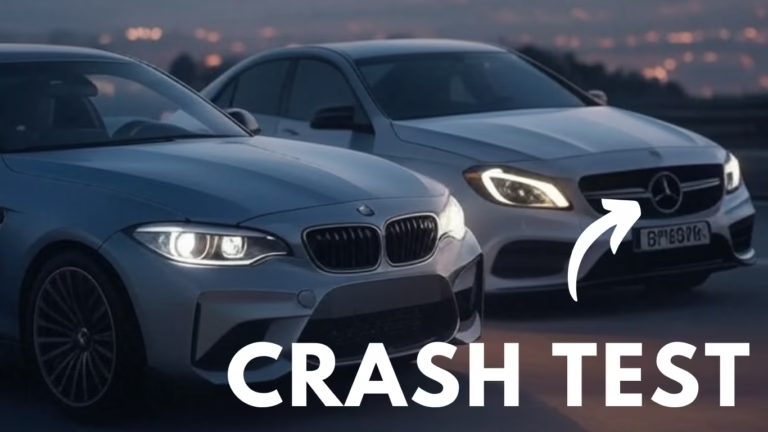

Ever wondered what would happen if two of the most beloved car brands, BMW and Mercedes, went head-to-head in a collision? Well, I’ve taken a deep dive into the digital realm of crash simulations to explore just that. Let’s talk about the BMW vs. Mercedes car crash test and what it tells us about their build quality.
BMW vs. Mercedes: The Simulation Setup
I found this fascinating simulation where at each speed increment, a BMW and a Mercedes are set to collide. Here’s how it unfolded:
- 5 MPH: At this snail’s pace, the impact is so minor it’s almost negligible. Both cars look like they could shake it off with a quick wash.
- 10 MPH: Here, things start to get interesting. The BMW shows some damage from the Mercs’ impact, hinting at Mercs’ superior build quality at this speed.
- 20 MPH: The Mercs makes a statement, visibly damaging the BMW’s hood. This speed starts to show the real test of engineering.
- 30 MPH: The damage escalates. The Mercs not only dents but significantly compromises the BMW’s hood, rendering it almost unusable.
- 50 MPH: Now, we’re seeing some serious action. The BMW takes a beating, with the Mercs literally embedding into its structure.
- 70 MPH: The BMW’s resilience is utterly tested here. It’s impressively crushed, showcasing the Mercs’ robust construction.
And the simulation goes on, with speeds hitting 90, 130, 150, 180, 200, 230, and finally 250 MPH. You might want to check out the video to see the full dramatic effect.
BMW vs Mercedes crash simulation😔😔😔 pic.twitter.com/vlryJxCnuA
— Tansu Yegen (@TansuYegen) September 4, 2023
What This Tells Us
Now, before we jump to conclusions about which car is “better” based on this simulation, let’s keep things in perspective:
- Simulations vs. Reality: Remember, these are computer models. Real-world performance can differ. To truly gauge the build quality, you’d need to look at actual crash tests on platforms like YouTube.
- Engineering Insights: This virtual crash test does highlight some aspects of build quality, but it’s not the whole story. Each brand has its strengths, and what we’re seeing is just one facet of their engineering.
Personal Takeaways
- BMW: I’ve always admired the sporty feel and dynamic handling of BMWs. But in this scenario, it’s clear they might not hold up as well in high-speed impacts.
- Mercedes: Known for luxury and safety, Mercedes seems to have an edge when it comes to surviving collisions under these simulated conditions.
Recent Posts
Why This Matters to Us
If you’re like me, choosing a car isn’t just about looks or speed; it’s about safety too. Here are a few points to ponder:
- Safety Features: Both brands are leaders in safety tech, but how they handle an impact at speed is crucial.
- Real-World Application: How does this translate to everyday driving? While we rarely hit such high speeds, understanding structural integrity is key.
- Consumer Decision: Would this sway my decision when buying a luxury car? Maybe, but it’s one piece of a larger puzzle.
Lessons Learned
- Simulations are Not Reality: They provide insights but should be supplemented with real-world data for a full picture.
- Build Quality Varies: Depending on the scenario, one brand might outperform another, but each has unique advantages.
- Safety is Multifaceted: Look beyond crash tests to features like airbag systems, electronic stability control, and more.
FAQs
Q1: Are these crash test simulations accurate?
They’re useful for understanding potential outcomes but should be taken with a grain of salt. Real-world tests are the gold standard.
Q2: Can I trust these simulations for choosing between BMW and Mercedes?
Not entirely; they’re just one aspect. I recommend looking at real crash test videos, safety ratings, and personal test drives.
Q3: What does this simulation say about Mercedes’ build quality?
It suggests Mercedes might have a stronger frame for high-impact scenarios, but it’s one piece of the safety puzzle.
Q4: How do BMW and Mercedes compare in actual safety ratings?
Both score highly in safety ratings, often earning top marks from institutions like Euro NCAP and IIHS, but specifics vary by model.
Q5: Should I be concerned about my car's performance in a high-speed crash based on these simulations?
Not necessarily. While informative, these simulations don’t cover all variables like safety features or actual crash physics in the real world.
So, next time you’re contemplating between a BMW or a Mercedes, remember, it’s not just about how they look or drive but how they’re built to protect you.



